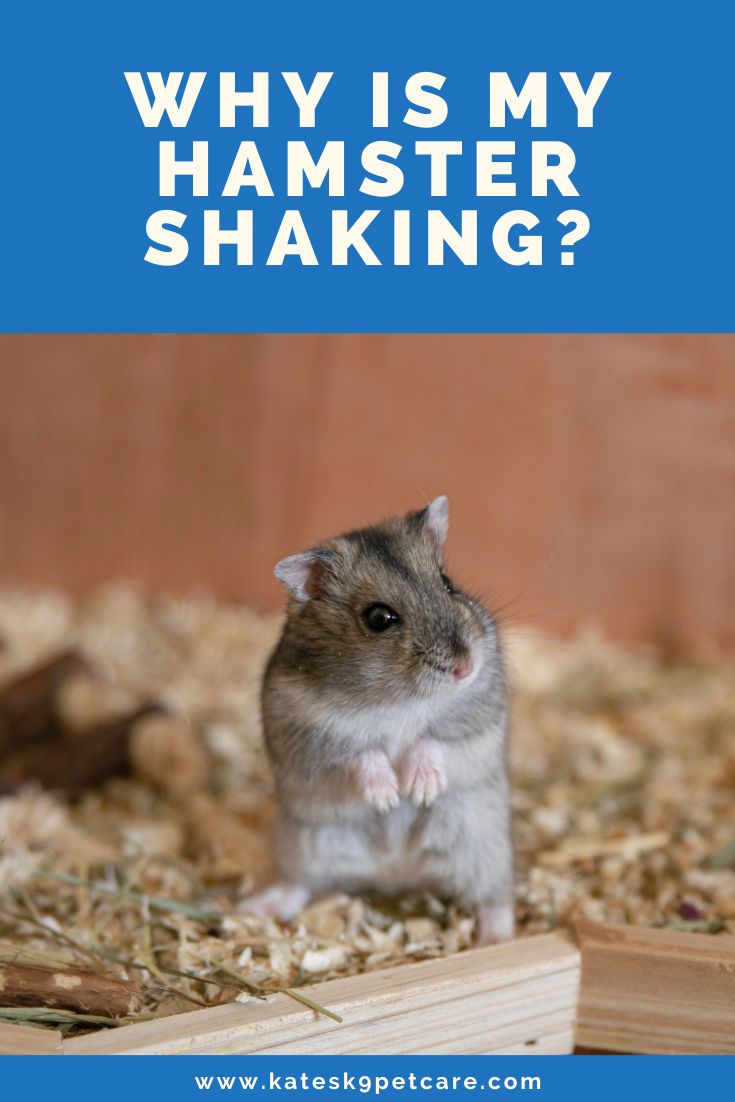Your hamster may be wobbling and falling over due to inner ear infection, neurological issues, or injury. It’s crucial to take your hamster to a vet for a proper diagnosis and treatment.
Hamsters are beloved pets known for their energetic and playful nature. However, if you notice your hamster wobbling and falling over, it may be a cause for concern. This unusual behavior could indicate underlying health issues that require prompt attention.
We will explore potential reasons for your hamster’s instability, providing insights into possible causes such as inner ear infections, neurological problems, or injuries. By understanding these factors, you can ensure the well-being of your furry friend and take appropriate action to address any health issues that may be affecting your hamster’s balance.

Credit: www.amazon.com
Possible Causes Of Wobbling And Falling Over
Potential reasons for a hamster wobbling and falling over include neurological issues, ear infections affecting balance, or simply old age affecting mobility. It’s essential to consult a vet for proper evaluation and care.
Health Issues
A hamster wobbling and falling over can be an alarming sight for any pet owner. It is crucial to understand the possible causes of this behavior to ensure the well-being of your furry friend. One potential reason for your hamster’s instability is underlying health issues.
Hamsters, like any living creature, can experience various health problems that may lead to balance issues. One possible condition is an inner ear infection, known as vestibular disease. This infection affects the hamster’s ability to maintain its balance, causing it to wobble and fall over at times.
Another health issue that could contribute to your hamster’s lack of stability is a neurological disorder. Hamsters may develop conditions like cerebellar hypoplasia, which affects the development of the cerebellum responsible for coordination and balance. This disorder can result in a wobbly gait and frequent falls.
Injury Or Pain
Injuries or pain can also be a source of wobbling and falling over in hamsters. These small animals are prone to accidents, and a fall or collision could lead to injuries affecting their ability to move properly.
One common injury that hamsters may experience is a sprained or broken limb. A fall from a height or getting caught in wires or tight spaces can result in such injuries. These injuries can cause discomfort and hinder the hamster’s mobility, leading to a wobbly gait and occasional falls.
Additionally, hamsters may suffer from joint issues, such as arthritis. This condition can cause stiffness, pain, and difficulty in movement, making it challenging for the hamster to maintain balance. As a result, it may appear wobbly and struggle to stay on its feet at times.
Old Age
Just like humans, hamsters also experience the effects of aging. As they grow older, their bodies undergo natural changes that can affect their physical abilities and coordination.
Old age can bring about muscular weakness and decreased agility in hamsters. This decline in their physical capabilities may cause them to wobble and lose balance more frequently. It is essential to provide extra care and support for older hamsters to help them navigate their surroundings comfortably.
While these are possible causes of a hamster’s wobbling and falling over, it is essential to consult a veterinarian to accurately diagnose and treat the underlying issue. Your vet can provide appropriate guidance and recommend necessary measures to improve your hamster’s health and well-being.
Symptoms To Look For
If you notice your hamster wobbling and falling over, it could be a sign of a health issue. Understanding the symptoms to look for can help you identify the problem and seek appropriate care for your pet.
Balance Problems
A common indicator of a health issue in hamsters is balance problems. If your hamster is having difficulty staying upright or appears unsteady when moving, it could be a red flag. Pay attention to any instances of stumbling or falling over, especially if these behaviors are unusual for your pet.
Unusual Movements
Unusual movements, such as uncontrollable shaking or trembling, may indicate an underlying health issue. Observe your hamster for any jerky or twitching motions, particularly while it’s trying to move around or engage in activities. These abnormal movements could signal a neurological problem or other health concern.
Treatment Options
When your hamster is wobbling and falling over, it’s essential to consider appropriate treatment options to address the issue. Here, we’ll explore the different steps you can take to help your furry friend regain their balance and well-being.
Consult A Vet
Seeking professional advice from a qualified veterinarian is crucial when your hamster is experiencing balance issues. A vet can conduct a thorough examination to determine the underlying cause of the wobbling and falling over. From inner ear infections to neurological conditions, a vet is equipped to diagnose and provide tailored treatment options for your hamster’s specific condition.
Provide A Comfortable Environment
Creating a cozy and safe habitat for your hamster is essential for their recovery. Ensure that their cage is equipped with soft bedding, ample space to move around, and avoid placing objects that could obstruct their movement. Implementing a calm and quiet setting can also contribute to reducing stress, which may aid in their rehabilitation.

Credit: www.reddit.com
Preventive Measures
Ensuring that your hamster remains healthy and happy is essential for its overall well-being. By taking certain preventive measures, you can minimize the risk of your hamster wobbling and falling over. Here are some important considerations:
Proper Diet
Feeding your hamster a balanced and nutritious diet is crucial in maintaining its health. A well-rounded diet helps strengthen your hamster’s muscles and improves its overall coordination. Make sure to provide a variety of fresh fruits, vegetables, and high-quality hamster pellets.
It is crucial to avoid feeding your hamster foods that can cause imbalance or nutritional deficiencies. Stay away from sugary or fatty foods as they may lead to obesity and hamster wobbling. Consult with a veterinarian or do thorough research to establish a proper diet plan for your hamster.
Safe Cage Setup
The environment in which your hamster lives plays a vital role in its well-being. Setting up a safe and suitable cage is crucial in preventing falls and wobbling. Here are some key factors to consider:
- Adequate space: Make sure the cage is large enough for your hamster to move around comfortably. Lack of space can lead to cramped movements and potential injuries.
- Appropriate bedding: Choose a bedding material that provides cushioning and prevents slipping. Avoid materials such as cedar and pine, as they can be harmful to your hamster’s respiratory system.
- Well-designed ramps and toys: Ensure any ramps or toys within the cage are securely attached and provide stability for your hamster while they are exploring or playing.
- Avoidance of heights: Keep the cage away from high surfaces or edges to minimize the risk of falls.
Regularly inspect the cage for any damages or hazards that could lead to your hamster wobbling or falling. Provide a comfortable and secure living space for your hamster to prevent any unnecessary accidents.
When To Seek Professional Help
If you notice persistent symptoms or a deteriorating condition in your hamster, it’s critical to seek professional help promptly. Hamsters wobbling and falling over could signify an underlying health issue that requires immediate attention.
Persistent Symptoms
When your hamster continually wobbles or falls, it may be a sign of a more serious health problem. Seek veterinary care if these symptoms persist.
Deteriorating Condition
If your hamster’s situation is getting worse and they are showing signs of severe imbalance, scheduling a vet appointment is crucial. Professional assistance can address the issue effectively.

Credit: katesk9petcare.com
Frequently Asked Questions For Why Is My Hamster Wobbling And Falling Over
Why Is My Hamster Wobbling And Falling Over?
Hamsters can wobble and fall due to various reasons like ear infection, stroke, or old age. It’s essential to observe your hamster’s behavior closely and consult a vet for proper diagnosis and treatment.
How Can I Help My Wobbling Hamster?
Create a safe and comfortable environment for your hamster with low-access areas, stable platforms, and proper bedding. Offer easily accessible food and water sources and minimize stress factors to support your hamster’s balance and mobility.
What Are Common Health Issues Causing Wobbling In Hamsters?
Common health issues leading to wobbling in hamsters include ear infection, neurological disorders, or vestibular disease. Regular vet check-ups, a balanced diet, and a clean living environment can help prevent and manage these issues effectively.
Can Stress Cause A Hamster To Wobble?
Yes, stress can contribute to a hamster’s wobbling due to anxiety, fear, or sudden changes in the environment. Providing a calm and predictable routine, proper handling, and a comfortable habitat can help alleviate stress and improve your hamster’s balance.
Conclusion
Wobbling and falling over in hamsters can be caused by various factors such as neurological issues, age-related weakness, or muscle injuries. It is crucial to observe your hamster closely and seek veterinary assistance if the problem persists or worsens. Maintaining a healthy and stimulating environment, providing a balanced diet, and ensuring proper handling can help prevent these issues.
Remember, the well-being of your furry friend is of utmost importance.
- Diy Delights: Creative Ideas For Hamster Toys And Accessories - April 13, 2024
- Creating A Healthy Habitat: Essential Tips For A Happy Hamster Home - April 13, 2024
- Enrichment Galore: Boosting Your Hamster’s Happiness With Emojis - April 13, 2024


